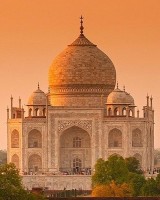Private guide in Palampur, guided tours in Palampur, India

Palampur
India
Language: English
Currency: Indian rupee (INR)
Information about Palampur
Palampur is a picturesque town in the Indian state of Himachal Pradesh, located at the foot of the Himalayas. It is known for its tea plantations, fresh mountain air, and peaceful atmosphere. This is the perfect place for those who want to escape city chaos and immerse themselves in natural harmony.
Here, Tibetan culture, Hindu traditions, and European comfort come together. Palampur attracts not only hiking lovers and eco-tourists but also those seeking spiritual rest or simply dreaming of silence and coziness against the backdrop of majestic mountains.
What sights should be visited in Palampur?
- Nurpur Tea Gardens – one of the main power spots in the region where you can learn about the tea harvesting and fermentation process.
- Shiva Badrinath Temple – a beautiful religious site popular among pilgrims.
- Jawali Mountain – an ideal spot for beginner climbers and panorama lovers.
- Tea Museum – small but informative center telling the story of the local tea industry.
- Ravi River – a great place for swimming and riverside walks.
- Tibetan Market – a hub offering handmade crafts and unique Tibetan cuisine.
- Dolma Ling Buddhist Monastery – a center for spiritual development and meditation.
- Barlachi Waterfall – a hidden natural gem accessible after a short forest walk.
- Yoga and Ayurveda Centers – popular spots for energy renewal and wellness retreats.
- Mungal National Park – a wild nature zone with trails and wildlife observation opportunities.
Why is it better to explore Palampur with a private guide in Palampur?
Private guides in Palampur will help you discover hidden trails, share the region’s history, and show places not found in regular travel guides. They tailor the itinerary to your interests—whether it's nature, culture, or wellness.
When is the best time to visit Palampur?
The best time to visit is from March to June and from September to November. During these periods, the climate is mild and the weather is stable. Winters can be cold, but it's a good time for meditation and inner reflection.
What language is spoken in Palampur?
The main languages are Hindi and Punjabi. English is widely used, especially in service and tourism sectors. Many members of the Tibetan community speak the Tibetan language.
What food should you try in Palampur?
Local cuisine features dishes made with natural ingredients and herbs:
- Chana Chat – spicy chickpea snacks seasoned with spices.
- Kulfi – traditional frozen dessert with fruity flavors.
- Roti with Dal – simple but nourishing dish.
- Tibetan Butter Tea – warming drink enjoyed during cold seasons.
- Aloo Paratha – fried flatbreads filled with spiced potatoes.
Is there shopping in Palampur and what souvenirs should you buy?
Shopping is centered around the Tibetan Market and local cooperatives. Souvenirs include woolen goods, tea, amulets, and yoga books. Antiquities cannot be exported without permission.
What clothing and shoes are suitable for a trip to Palampur?
Light cotton clothes are suitable for summer months, while warm jackets, scarves, and sturdy shoes for rocky terrain are needed in winter.
What currency is used in Palampur?
The official currency is the Indian rupee (INR). Currency exchange is best done at banks or hotels. Credit cards are accepted in many establishments.
What behavior is appropriate in public places in Palampur?
Respect local culture: avoid photographing people without permission, maintain silence in monasteries, do not litter, and respect religious customs.
How safe is Palampur for tourists?
The town is considered very safe. Potential issues may involve poor weather conditions on mountain roads and rare cases of scams in small shops.
What to do in Palampur in the evening?
In the evening, you can visit tea houses, listen to mantras in a monastery, or simply enjoy the mountain views. Private guided tours in Palampur are possible even after dark.
Is Palampur interesting for children?
Yes, especially if you choose a tour with private guides in Palampur tailored for kids. They’ll enjoy tea plantations, waterfalls, and learning new words in Tibetan.
Who lives in Palampur and what religion is practiced there?
The population is around 40 thousand people. The dominant religion is Hinduism, though there is a significant Tibetan Buddhist community. Locals are friendly and open-minded.
What is the environmental situation like in Palampur?
Ecology is at a high level: little industry, lots of greenery, clean rivers, and fresh mountain air. The town actively promotes eco-tourism and sustainable living.
How to get to Palampur and which airport to fly into?
The nearest international airport is in Delhi. From there, you can reach Palampur by bus, train, or book a transfer through private guides in India. An alternative option is Gaggal Airport (Bir Billing), closer but with limited flights.
Why should you visit Palampur?
Palampur is a blend of nature, culture, and spirituality. Here, you can recharge from city life, dive into self-discovery practices, and enjoy breathtaking landscapes. It's the perfect place for inner journeys.
5 reasons to visit Palampur
- Breathtaking tea plantations.
- Unique yoga and Ayurveda centers.
- Proximity to the Himalayas and trekking opportunities.
- Option to book personalized tours with private guides in Palampur.
- Living Tibetan culture and traditions.
Our tips for tourists in Palampur
- Bring a warm sweater even in warm seasons — nights can be chilly.
- Don’t forget to drink water and monitor oxygen levels during climbs.
- Try tea straight from the plantation — it tastes completely different!
- Attend an early morning meditation session in a monastery — unforgettable experience.
- Take photos with the mountains right after sunrise — best lighting of the day.



 French
French Spanish
Spanish Russian
Russian


